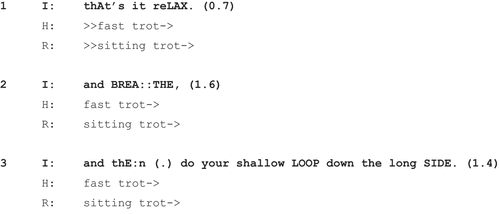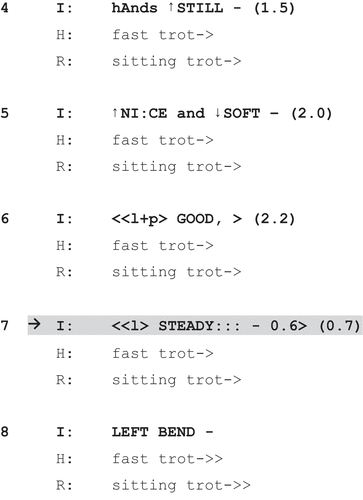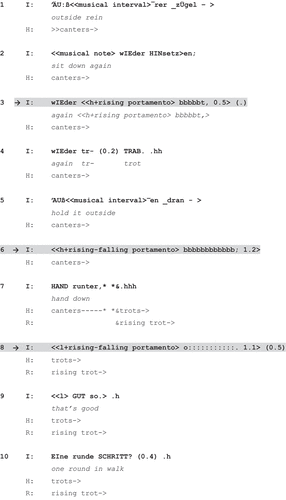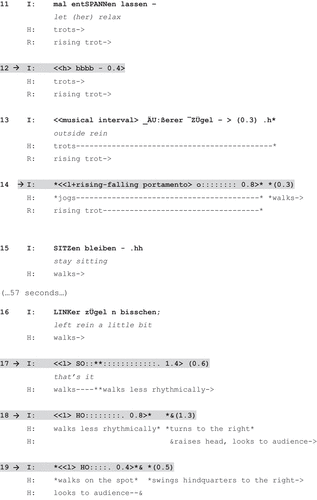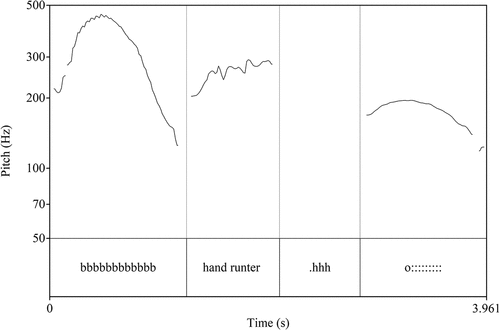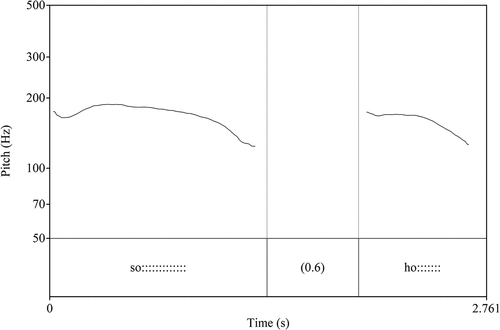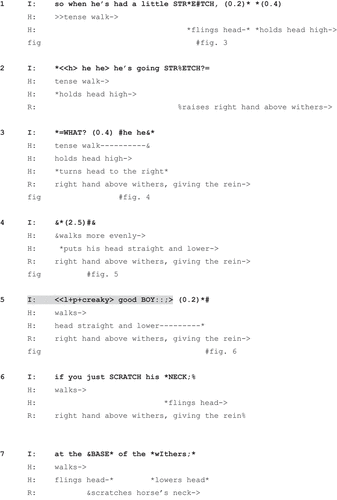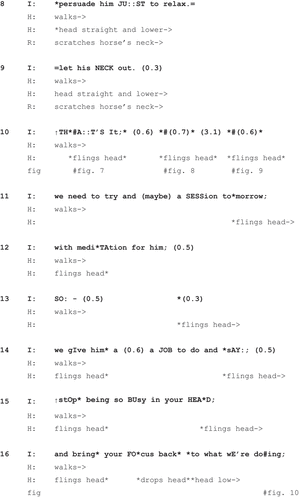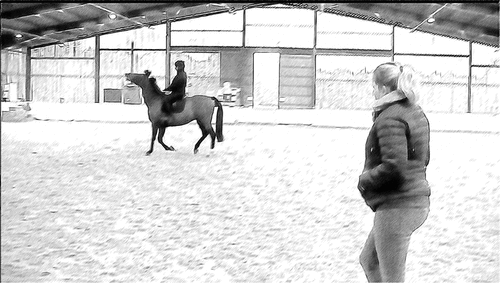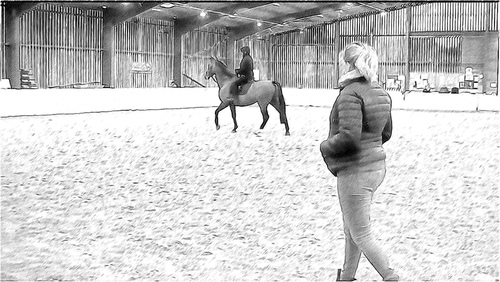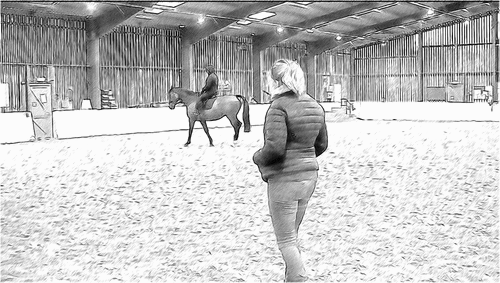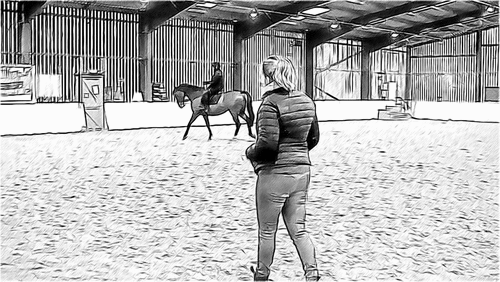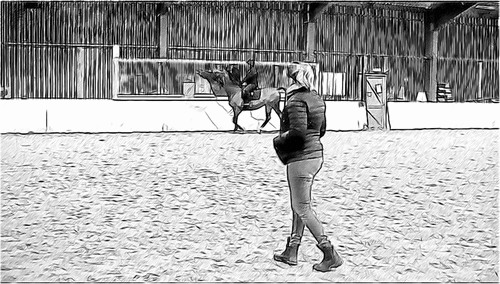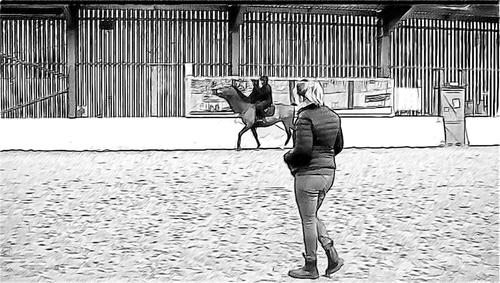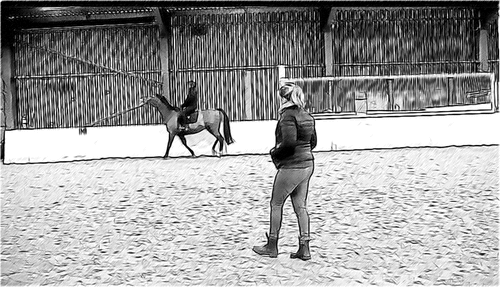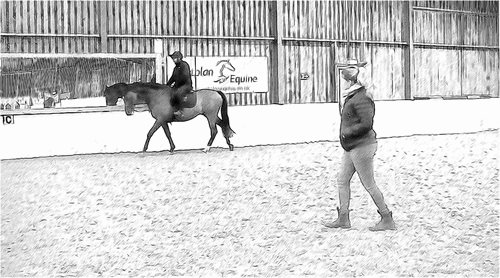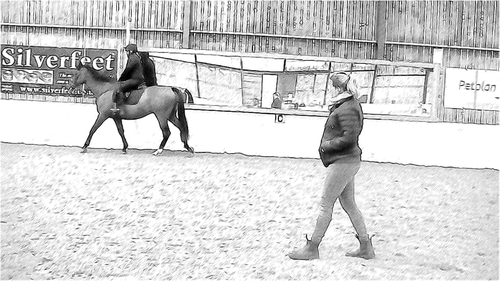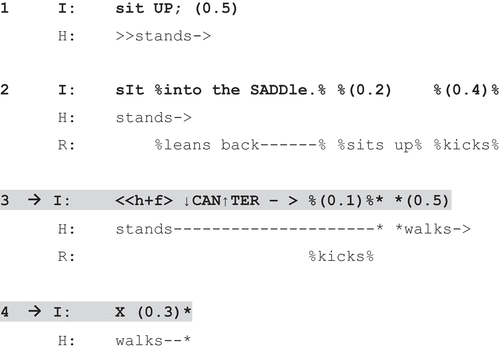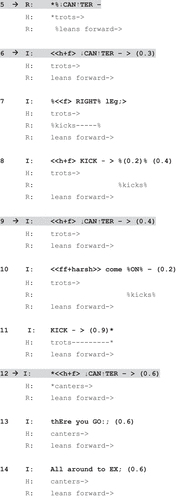ABSTRACT
This analysis shows how, in horse-riding lessons, riding instructors use prosody and other sound patterns to design their talk for human and equine recipients at the same time, while orienting to distinct contributions from each. Practices for doing so include nonlexical vocalizations, marked prosodic delivery, and conventionalized lexical-prosodic bundles. Parallel recipient design allows turn-holders to pursue a single activity that is to be performed jointly by the recipient pair. Parallel recipient design is shown to be distinct from alternating recipient design, to be found during multiactivity. Parallel recipient design can be delivered consecutively, with talk designed to mobilize the rider followed by talk designed to mobilize the horse; or simultaneously, with lexical items performing one action to the rider and their prosodic delivery performing another action to the horse. The data are recordings of naturally occurring horse-riding lessons, mostly in English; some data are in German, with English translations.
Talk-in-interaction is fitted to, and simultaneously co-constructs, the recipients for whom it is designed. The present study explores multi-recipient design in instructional interactions in which two recipients are being mobilized to perform a joint action. The context is horse-riding lessons and thus includes human and equine recipients. Specifically, the article explores instruction talk by riding coaches that includes talk conventionally designed for horses. Extract 1 shows the first noticing of the phenomenon: a turn component that seems to address not the rider alone but the horse–rider pair together. In the transcripts, riding instructors are referred to as I, horses as H, riders as R, and the horse–rider pair as H/R.
Extract 1. Riding lesson 20220330 Part 2 8.08-08.26
The extract shows part of a private riding lesson in which the horse is trotting faster than desired. Earlier in the lesson, the instructor describes him as “feeling a bit sprightly.” The rider is riding in “sitting trot,” that is, she remains seated in the saddle rather than “posting” or “rising” with every second stride. Sitting to the horse’s trot can have the effect of slowing down the horse’s movement. Much of the instructor’s talk is aimed at guiding the rider to reduce the horse’s speed with directives to “relax,” “breathe,” and hold the hands “still” and “nice and soft.” The coach’s instructions include the item steady (line 7). The word is delivered with low overall pitch register, held on a single level tone, and its final—lexically unstressed—syllable is lengthened considerably (.6 s).
“Steady” is a lexical directive to the rider to bring about a steady speed, but its prosody also makes it a candidate for a horse-oriented turn. Its held level tone, low pitch, and lengthening are reminiscent of other horse-oriented soothing vocalizations, such as whoa or [ho:] (see below). As a lexical-prosodic bundle the item seems to be addressed to the horse–rider pair together, directing the horse to slow down and the rider to bring about a slower speed. In contrast, the items that precede and follow it are addressed to the rider alone. This first noticing of a turn component that is potentially oriented to horse and rider as a joint recipient pair led to a deeper analysis of multi-recipient turn design in horse-riding lessons. The following sections will discuss recent work on recipient design, interspecies interaction, and animal-directed speech. Subsequently, the data and methodological approach will be presented. In the analysis section, a distinction will be made between “alternating” and “parallel” recipient design before the article focuses on practices for parallel recipient design. The article ends with concluding observations.
Designing talk for multiple recipients
Recipient design—that is, the “respects in which the talk by a party in a conversation is constructed or designed in ways which display an orientation and sensitivity to … co-participants” (Sacks et al., Citation1974, p. 727)—has been explored in the context of person reference (Sacks & Schegloff, Citation1979; Schegloff, Citation1996), epistemics (e.g., Deppermann, Citation2015), and the social construction of co-participants (e.g., Wilkinson, Citation2011) and relationships (e.g., Pillet-Shore, Citation2012). Deppermann and Blühdorn (Citation2013) distinguished between the factual recipient, who has a range of qualities, including those that are inaccessible to co-participants and analysts; and the socially constructed addressee, who is—and can be shown to be—ascribed qualities through others’ talk. Designing talk for multiple recipients requires additional interactional work (Schegloff, Citation1996), as co-participants may hold different and potentially shifting participant roles (Clark, Citation1996; Goffman, Citation1981; Levinson, Citation1988). Turn-holders may design their talk for certain subgroups of recipients (e.g., Meyer & von Wedelstaedt, Citation2019), an overhearing audience (e.g., Heritage, Citation1985), or distinct individuals (e.g., Goodwin, Citation1979; Schegloff, Citation1996). Hitzler (Citation2013, pp. 118–120) describes “oscillating” recipient design that alternates between talking to and talking about a co-participant.
In their critique of the concept of “other-orientation as an a priori condition of every semiotic action,” Deppermann and Schmidt (Citation2016, p. 369) argue that other-orientation must be available to empirical analysis. They introduce several “boundary cases” (p. 380, author’s translation), which include talk in the absence of other participants; talk that is spontaneously expressive of affect or pain; and talk for participants with reduced communication skills, who are nevertheless designed as if they were “fully competent partners” (p. 384, author’s translation). The last phenomenon is referred to as “imagined other-orientation” (p. 384), aimed at co-participants who are not fully interactionally competent (e.g., children, technology) or not physically present (e.g., psychosis, prayer). Animals are classed with these types of recipients. The authors’ example of animal-directed talk is one in which a falconer at a falconry display speaks to a bird of prey as if to a human drinking buddy for comic effect, as the bird vomits while perched on the falconer’s arm. Deppermann and Schmidt argue:
Vom Tier werden kein verantwortliches Handeln und keine Verstehen anzeigende, die Zuschreibungen bestätigende Reaktionen erwartet. (“The animal is not expected to act responsibly and to show reactions that display understanding and that confirm the ascriptions (of properties).). (2016, p. 391, author’s translation)
This conceptualization of animal-directed talk refers to talk that is designed as if for an animal but is in fact designed to manage human interaction (here, the falconer’s interaction with the audience). In contrast, talk that is directed at animals as the primary recipients may indeed involve human expectations that animals “show reactions that display understanding” (Deppermann & Schmidt, Citation2016, p. 391)—for example, in the case of commands given to dogs (Jeannin et al., Citation2017) and in talk designed to mobilize horses.
Interaction between human and nonhuman animals
As noted, some work on interspecies interaction has approached animal-oriented talk as a way of understanding human talk. Bergmann (Citation1988), Huneke (Citation2004), Tannen (Citation2004), and Roberts (Citation2004), and Torres Cajo and Bahlo (Citation2016) focus on pets as “thematic” (Bergmann, Citation1988, p. 305) resources that humans draw on to manage their interactions. Other research has tried to unpack human–nonhuman interaction as an object of study in its own right: for example, at the vet’s office (Llewellyn et al., Citation2022; Lohi & Simonen, Citation2021; MacMartin et al., Citation2014), in training and other working environments (Cornips, Citation2022; Due, Citation2021; Mondémé, Citation2019), in experimental settings (Simonen & Lohi, Citation2021), and in everyday interactions (Goode, Citation2006; Harjunpää, Citation2022; Laurier et al., Citation2006; Mondémé, Citation2018, Citation2020, Citation2021a, Citation2021b). Much of this work is concerned with dogs, but it also includes cats and reptiles (MacMartin et al., Citation2014), dairy cows (Cornips, Citation2022), and parrots (Harjunpää, Citation2022).
Human–horse interaction has been the object of a small number of empirical studies, with most research emphasizing the nonverbal communication between horses and humans (Birke, Citation2017; Brandt, Citation2004, Citation2006; Zetterqvist Blokhuis & Lundgren, Citation2017). Riding lessons have been explored from an interaction-relevant perspective by Norris (Citation2012), Dashper (Citation2016), Zetterqvist Blokhuis (Citation2019), Lundesjö Kvart (Citation2020), Lundgren (Citation2017, Citation2020), Lundesjö Kvart and Melander Bowden (Citation2022), and Rettig (Citation2020, Citation2022), with a primary focus on how the communication between rider and horse is taught and acquired, and, in the case of Lundesjö Kvart (Citation2020), how it is temporally organized. Lundgren (Citation2017) describes several nonverbal practices used by riding instructors, including embodied depiction, prosodic resources for timing instructions to fit ridden activities, and “onomatopoetic constructions” (p. 67) aimed at horses.
Designing talk for nonhuman animals
A range of studies have examined animal-directed speech, often focusing on its similarities with talk directed at infants. Most of this research has been concerned with dogs, except for Burnham et al. (Citation2002), who also include cats, and Xu et al. (Citation2013), who include parrots. Similarities with infant-directed talk include high pitch register (Burnham et al., Citation2002; Jeannin et al., Citation2017; Mitchell, Citation2001) as well as repetition, short utterance length, and limited syntactic complexity (Hirsh-Pasek & Treiman, Citation1982; Jeannin et al., Citation2017; Mitchell, Citation2001; Mitchell & Edmonson, Citation1999). Xu et al. (Citation2013) show that hyperarticulation, a feature of infant-directed speech, can be observed in talk directed at parrots but not dogs.
Like human-only talk, pet-directed speech varies greatly according to the social actions in which humans and pets are engaged. Jeannin et al. (Citation2017) describe women’s dog-directed speech in four conditions (separation, reunion, play, and commands). They show that high pitch register is most frequently used in reunions, which also show more pitch variation. In the separation condition, low pitch register is more common, and there is high variation in intensity. The authors attribute this “imperative style” (p. 506) to humans’ attempts to get dogs to stay in the room on their own. Overall, the authors suggest that “female dog owners use a high-pitched voice when they want to express praise or affection and a low-pitched voice when they want to control the dog” (pp. 506–507).
Studies that describe animal-directed speech without comparing it to baby talk have reported similar as well as additional observations. Bolton’s (Citation1897) early collection of the many language items that different cultures use to address domestic animals suggested that such terms “are chiefly monosyllabic and dissyllabic, and are generally repeated in groups of three” (p. 65).
MacMartin et al. (Citation2014) mention high pitch register for greeting sequences between vets and dogs. Their analysis of I know responses to animals in distress also contains several cases of low pitch register and narrow pitch spans, and at times low volume. The authors link this prosodic design to the “soothing, calming character” (p. 165) of the vet–animal interaction.
Harjunpää (Citation2022) describes how humans match certain aspects of animals’ vocalizations, thus treating animals as having initiated the interaction.
Designing talk for horses
Much human interaction with horses is haptic or otherwise embodied, in the form of riding, brushing, shoeing, and so on (Mondémé, Citation2021b). In contrast, this study is concerned with talk designed for horses, which in English-speaking communities may come in the form of certain lexical phrases (such as good girl and good boy), marked prosodic delivery, and community-specific nonlexical vocalizations (Keevallik & Ogden, Citation2020a), such as lateral clicks, lip kissing, and lip fluttering.
Lundgren’s (Citation2017) analysis of Swedish dressage trainers’ communication patterns mentions onomatopoetic expressions “used to encourage or calm down the horse” (p. 76, author’s translation). These include clicking to encourage the horse to go more forward, and the Swedish vocalization “ptro,” “a signal to the horse to slow down or calm down” (p. 76), which Lundgren equates with English “whoa.” Like the present study, Lundgren finds that riding instructors use these vocalizations during riding lessons. “It is common for the trainer to click during training when the horse needs to increase the pace or energy level. … the trainer can also ptro when the horse becomes too excited” (Lundgren, Citation2017, p. 76).
While there are voice commands (Waran et al., Citation2007) that have locally conventionalized and distinctive forms of prosodic delivery (such as ↓CAN↑TER in Extract 4), much horse-oriented talk is distinct but also phonetically underspecified (Keating, Citation1988, in Keevallik & Ogden, Citation2020b). For example, although lip fluttering presents a clearly identifiable articulation pattern, its duration, pitch contour, and breath force vary greatly across individual occurrences. Uses may also vary cross-culturally. For example, in the United Kingdom, high-pitched lip-fluttering with rising pitch is used to send horses forward. In Germany, lip-fluttering with varying pitch patterns and duration is used to slow horses down. Both uses are attested in the data for the current study.
In order to calm down excitable or frightened horses, many riding communities make use of a combination of low-pitch register and vowel lengthening ( and ): “By using your voice in long, low sounds (‘Eeeasssyyy … .’ and ‘Whoaaaaaaaa … .’) … you quiet the horse’s autonomic nervous system and override the flight reflex.” (Tellington-Jones & Lieberman, Citation2006, p. 16). However, while certain prosodic forms may appear nonarbitrary to humans, the human-ascribed meanings or functions of such forms do not seem to be intrinsically meaningful to horses but are instead learned. An experimental study by Heleski et al. (Citation2015) shows that horses’ heart rate and learning of a frightening task are not affected by whether the verbal reinforcement “good horse” is spoken in a “soft soothing manner” or not, or whether the phrase “quit it” is spoken in a “loud sharp manner” (p. 42), but instead by repetition. This finding speaks to Deppermann’s and Blühdorn’s (Citation2013) distinction between factual recipient and socially constructed addressee, as humans may construct horses as sharing the iconic representation of “long, low” tones as calming and “sharp harsh” tones as reprimanding (Heleski et al., Citation2015, p. 41) when there is little evidence that they do.
Data and approach
Riding lessons are what can be called a concurrent instructional setting, in which instruction and learner performance take place in parallel. Unlike in consecutively organized learning interactions, such as some forms of music teaching, in which teacher instructions and learner performances are organized by participants into separate consecutive slots (Szczepek Reed et al., Citation2013), riding instructors frequently teach at the same time as their students ride (Lundesjö Kvart & Melander Bowden, Citation2022; Szczepek Reed, Citation2023). Instructors’ contributions are primarily talk-based, with some use of embodied demonstrations and depictions (Lundgren, Citation2017), depending on individual participants and the learnables being pursued. Contributions by rider–horse pairs are mostly embodied, as they are afforded virtually uninterrupted opportunities for putting instructions into practice during a given instruction sequence. Displayed spoken recipiency from riders is comparatively rare; riders’ recipient actions consist primarily of their embodied compliance with instructions (Mondada, Citation2018b).
The data underpinning this study are approximately 22.5 hours of video-recorded horse-riding lessons. The style of riding is mostly flat work (dressage); five recordings include jumping. The corpus contains 15 private riding lessons (8 hr 40 m) recorded in the United Kingdom. Eighteen riding coaches were approached via the database of the British Horse Society; three additional coaches were reached by word of mouth. Six coaches and their clients agreed to have up to three of their lessons recorded, each time with different rider–horse pairs. All research participants have given their consent to be audio- and video-recorded and for their anonymized data to be disseminated for research purposes.
The corpus also contains 13 hours, 54 minutes of publicly available YouTube recordings of riding lessons and clinics from the United Kingdom, the United States, Canada, and Germany. The YouTube corpus holds 10 full-length clinics (that is, “masterclass” type one-to-one lessons that are open to the public) recorded by audience members (in English, 5 hr 32 m); five full-length clinics recorded for broadcasting (in German, 5 hr 38 m); two private riding lessons (in English, 44 m); two shorter segments of private group lessons (in English, 23 m), and six full-length group lessons recorded for instructor training purposes (in English, 1 hr 37 m). Where this study uses YouTube recordings for public dissemination, personal consent has been given by the creators of the content except where repeated invitations to do so were not met with a response. In those cases, extra care was taken to anonymize transcripts, and no images were used. The transcript notations for speech are adapted from GAT2 (Selting et al., Citation2009), see Appendix. Notations for embodied actions follow Mondada (Citation2018a, Citation2019). The transcripts show only those features that are relevant to the analysis. Where horse–rider actions require expert knowledge to understand them, or where participants’ talk draws on relevant expertise, this is made explicit in the analysis (Arminen & Simonen, Citation2021).
The work is positioned within the field of interactional studies of embodied skills instruction (see Ehmer and Brône, Citation2021, for a substantial overview). The analytical frameworks for the study are Conversation Analysis (Schegloff, Citation2007) and Interactional Linguistics (Couper-Kuhlen & Selting, Citation2018). This means that the analysis is focused on observable linguistic and embodied actions that participants themselves orient to as relevant. In horse-riding lessons, judging whether a rider’s embodied action has occurred or not is a “members’ problem” (Hutchby & Wooffitt, Citation2008, p. 50). Riders’ actions, especially the riding aids, are often not visually accessible; in fact, their invisibility is desired. For example, one instructor in the corpus refers to the giving and taking of the reins as “eventually” becoming “a secret” between rider and horse that cannot be seen by others (Riding lesson 20220605, Part 1, 9.37–54). Instructors may solve this issue by inferring a rider’s actions and their effectiveness from the horse’s movements rather than from the rider’s observable behavior (Instructor in 20220329, personal communication). As the visual inaccessibility of certain rider actions is a concern for the participants themselves, an analysis of instruction-relevant conduct shows which actions are being made relevant by participants, and how.
The analysis remains cautious when it comes to ascribing actions to horses, especially in the response slot following instructions. First, the analytical challenge of identifying and interpreting horses’ behaviors must be acknowledged. Second, the primary communicator with the horse is the rider, not the riding instructor. Horses’ actions are therefore likely to be mobilized either exclusively or at least partially by the rider, despite any horse-mobilizing talk by the instructor. With these constraints in mind, horses’ actions should not be interpreted uncritically as responding or not responding to instructor talk. The analysis below focuses on instructors’ recipient design for the horse–rider pair. The horse is treated analytically as a socially constructed “addressee” in Deppermann’s and Blühdorn’s (Citation2013) sense.
Designing talk for multiple but distinct recipients: alternating vs. parallel recipient design
This study describes parallel recipient design—that is, turn design for multiple but distinct recipients who perform a joint activity and project. The term “activity” is used here to refer to an interactional unit (Mazeland, Citation2019) that consists of “multiple, normatively ordered sequences of action” (Robinson, Citation2012, p. 257) with an overarching topical or goal-oriented coherence (Heritage & Sorjonen, Citation1994). Robinson’s (Citation2012) examples of activities include the opening and closing of an interaction but also opening a birthday present (Good & Beach, Citation2005). In addition, he also describes “mega-activities or mega-structures,” which “can constitute a majority of an entire interaction” and “appear to be more common … in institutional … interaction” (Robinson, Citation2012, p. 267). For these, Robinson uses the term “project,” giving the example of physician–patient visits (see also Robinson, Citation2003), which have “an overall structural organization that involves multiple, ordered, medical activities” (Citation2012, p. 267).
Along the same lines and following Robinson (Citation2003), Reed and Szczepek Reed (Citation2013) describe the music masterclass as an “interactional project” that is constructed of several component activities, which are in turn constructed of multiple sequences and actions. In the analysis below, the term “project” is used to refer to the overall organizing structure of the interaction, which is the riding lesson. The term “activity” is used to refer to multiple action sequences achieved by rider and horse together with the goal of jointly accomplishing a task, such as relaxing the horse or transitioning from one gait to another.
Parallel recipient design is oriented to a joint horse–rider project and activity but can, if necessary, orient to individual actions to be performed by the horse and/ or the rider. In Extract 1, the instructor designs her item steady as orienting to recipients’ distinct contributions by prosodically encouraging the horse to calm down while lexically encouraging the rider to bring about a steadier pace. In directing both the rider and the horse to slow down, the instructor pursues the same joint activity with both recipients, to be accomplished by the pair collaboratively. The parallel use of horse- and human-oriented talk treats the two participants as a multi-species recipient pair and single participant unit. A turn design that makes use of similar interactional resources is what can be called “alternating recipient design,” by which distinct multiple recipients are being addressed, but which is not oriented to the same activity, project, and participation framework. Alternating recipient design can be found in multiactivity. For example, Mondada (Citation2014) describes a surgeon who is alternately engaged in an operation with his assistants and a demonstration to an audience, designing separate social actions for each. Another example is LeBaron’s and Jones’s (Citation2002) analysis of interaction in a beauty salon, where a client is simultaneously engaged in “beautification” with the beautician and in a group discussion about animals with other clients in the salon (p. 554.).
While alternating recipient design allows turn-holders to address distinct (groups of) recipients successively and to pursue distinct interactional projects and activities with each, parallel recipient design is oriented to a single project and allows turn-holders to mobilize distinct recipients to perform a joint activity, to which each recipient nevertheless makes distinct contributions.
Forms of parallel recipient design
The flexibility afforded by vocal sound patterns means that parallel recipient design can be accomplished in different temporal and action formats. Its temporal organization is linguistically determined. In the simultaneous format, lexical items perform one action to the rider while their prosodic delivery performs the same or a different action to the horse. In the consecutive format, chunks of talk addressing the rider are followed by chunks of talk addressing the horse. In addition, parallel recipient design can have different action formats, in that the horse–rider oriented turn can either perform the same (or closely related) actions to both horse and rider, or one action to the rider and a different action to the horse. In all cases, the instructor turn as a whole orients to the accomplishment of a single joint activity by the horse–rider pair. Individual contributions by horse and rider can be targeted by different turn components where necessary.
Extract 2 shows three temporal and action formats: consecutive turn components performing the same or separate actions; and simultaneous turn components performing separate actions. In the extract, nonlexical vocalizations and marked prosodic delivery contribute to the pursuit of slowing down the horse’s tempo and, later in the extract, dealing with her displayed nervousness. The extract is taken from a German dressage clinic. Prior to the transcribed section, the horse started building up undesired speed in canter. Following Ogden (Citation2020), the transcript symbol ǁ is used to represent lateral clicks.Footnote1
Extract 2. 20151013 13.15 - 13.32; 14.29-14.42
The instructor’s directives at lines 1–4 are aimed at reducing the tempo of the horse’s canter and bringing her back to trot. The first directives (lines 1–2) are oriented to the rider (outside rein, sit again). The directive at line 3 contains a short burst of lip fluttering, delivered in a high pitch register and with rising portamento. This is preceded by a “human” language item, wieder (again), whose delivery is unmarked; it is not possible to determine whether a human-oriented turn is broken off, or whether the nonlexical vocalization is designed as part of a turn component starting with wieder. The lip fluttering, which is designed to mobilize the horse to slow down, performs a different action to the preceding turn component, which is designed to mobilize the rider to perform an embodied action (sit down again, line 2); but it performs a closely related action to the following turn component (again trot, line 4), which mobilizes the rider to come back to trot and, in doing so, to slow down. The temporal format is thus consecutive, with turn components performing first separate and then related actions.
Despite the instructor’s directive to trot, the horse and rider pair continue in canter (lines 5–7). Following another directive to the rider (line 5, hold it outside), the instructor produces a longer instance of lip fluttering with rising-falling portamento and high pitch register (line 6). The vocalization is followed by another directive to the rider only (line 7, hand down). Again, the parallel recipient design involves a combination of rider- and horse-oriented talk in pursuit of one joint horse–rider activity (transitioning back to trot) by addressing their distinct contributions: The rider is directed to perform embodied actions designed to bring about the change in the horse’s behavior, while the horse is encouraged to slow down.
Immediately following the horse’s transition to trot, the instructor produces another nonlexical vocalization, a lengthened and low-pitched [o] with rising-falling portamento (line 8). gives a visual impression of the pitch range for the nonlexical vocalizations at lines 6 and 8. The frequency analysis shows the lip fluttering at line 6, rising up to 447 Hz at its highest point in the pitch curve and falling to 133 Hz at its end; the rider-oriented talk at line 7, ranging between 203 and 290 Hz; and the low-pitched [o] at line 8, rising no higher than 195 Hz and falling to 115 Hz. At lines 10–11, the instructor gives the directive to come back to walk and “let her relax,” both directives being oriented at a further reduction in tempo and energy. As the horse–rider pair keep trotting, the instructor produces a short high-pitched lip fluttering (line 12), and, as there is still no transition to walk, another lengthened low-pitched [o] with rising-falling portamento (line 14), during which the horse first jogs and, overlapping with the completion of the vocalization, transitions to walk.
Approximately one minute later, during which the horse has shown some nervousness and the instructor has spoken on the topic of how to make an excited horse feel secure, these more general instructions end in the local action directive at line 16. At this point, the horse–rider pair are walking comparatively calmly but are approaching the side of the arena where the audience are seated, which has been identified earlier as potentially frightening the horse (data not shown). The instructor produces a positive assessment of the rider’s actions, using the lexical item “so” (Barske & Golato, Citation2010; Stukenbrock, Citation2010), which is used throughout this interaction (see also lines 20, 23, and 27). German “so” literally translates as “like this”; however, in instruction sequences it is used as an assessment receipt (Reed, Citation2019) and can be translated as “that’s it.” The prosodic delivery of “so” at line 17 is low-pitched and delivered with considerable lengthening, such that its prosodic form closely resembles the nonlexical vocalizations [o::] at lines 8 and 14, and [ho::] at lines 18 and 19. shows the similarity in pitch span and contour for lines 17 and 18. The phonetic form of “so” includes the same vowel as the nonlexical vocalizations, which allows the instructor to deliver a positive assessment to the rider via the lexical content and at the same time a (potentially preemptive) soothing vocalization to the horse via the phonetic and prosodic design. In this instance, the temporal format is simultaneous, due to the flexibility afforded by the phonetic-prosodic form. The two components perform separate social actions: While the lexis performs the assessment to the rider, the prosodic delivery is designed to calm the horse.
During the instructor’s production of “so,” the horse begins to walk faster. The instructor meets this with two nonlexical vocalizations “ho,” delivered with the same low-pitched and lengthened prosody (lines 18, 19). Following the first “ho,” the horse raises her head and looks to the audience, which is met with another “ho” by the instructor (line 19). The horse now swings her hindquarters to the right, into the arena, and turns the front of her body to the left and back, with her feet briefly leaving the floor. As the horse and rider are in the process of turning back in the direction in which they were originally facing, the instructor directs the rider to “now trot on” (line 25) and follows this up with two lateral clicks (line 26). This mobilizes horse and rider with two closely related actions—that is, the verbal directive to the rider to get the horse to trot and the clicking designed to move the horse forward. The two are delivered in the consecutive temporal format.
Extract 2 shows parallel recipient design being achieved through nonlexcial vocalizations and through the marked prosodic delivery of a human-oriented lexical item. In the following extract, both the lexical item and its marked prosody are oriented to the horse. In this sequence from a private riding lesson, the horse has shown signs of tension throughout the lesson, which have included a tense walk and head flinging. 42 seconds prior to the transcribed section, the instructor has asked the rider to “let him have a little stretch then,” which refers to giving the horse a break on a long rein. Stretching the neck low is seen as a sign of relaxation.
Extract 3. Riding lesson 20220605 Part 2 5.29-6.17
Line 1 shows the instructor abandoning a directive referring to the time after the stretching, possibly in response to continued head flinging by the horse (). She then ventriloquizes (Mondémé, Citation2018; Tannen, Citation2004) the horse (stretch? what?, lines 2–3) as the horse keeps his head up high and looks to the right, away from the circle and in the direction of the arena wall (line 3, ). From line 4, the horse brings his head straight again and lowers it slightly () as the rider raises and brings forward his outside hand to give the horse more rein (lines 2–6, ). The instructor responds to the horse’s adjustment with the phrase good boy (line 5), which she delivers with low pitch register, reduced loudness, and creaky voice quality. Subsequently, she asks the rider to scratch the horse’s neck (lines 6–9). Both the horse-oriented and the human-oriented turn components address the horse’s relaxation and stretching of his neck. They do so in a consecutive temporal format and accomplish separate actions: praise and encouragement for the horse, and a directive to perform an embodied action to the rider.
While the rider scratches the horse’s neck, the horse lowers his head and stops flinging it for a short period (lines 7–9). Another period of head flinging follows (lines 10–16, ), during which the instructor jokingly suggests meditation (line 12). As the rider sits calmly with a long rein, the horse once again lowers his head (lines 16–18, ) but soon starts flinging it again, holding his head higher in between flings (lines 18–21, ). The instructor repeats the phrase good boy, this time with a high pitch onset and a musical interval on the two syllables, as well as lengthening on boy (line 19). Musical intervals have been shown to design talk as routine (Ladd, Citation1978; Szczepek Reed, Citation2006).
Unlike the first instance of good boy, which is positioned in response to the horse lowering his head, the second good boy occurs in response to further tension displays (line 18). The use of a positive assessment despite the horse’s undesired behavior co-constructs the horse as nevertheless doing well and orients to the longer sequence of on-and-off relaxation rather than the individual head flinging that immediately precedes the turn. The stylized prosody further downgrades the situation by treating it as routine. Finally, the level pitch at the end of the phrase treats the horse’s and rider’s attempts at relaxation as ongoing rather than complete (Szczepek Reed, Citation2023), orienting to the overall sequence rather than the single event.
The following extract is another example of parallel recipient design in a simultaneous temporal format. Unlike “so” in Extract 2, in which lexis and prosody performed separate actions to horse and rider, here the instructor’s directive is the same to both recipients. This is done via the use of a voice command: The lexical item is one that mobilizes the rider to bring about a change in the horse (“canter”), while the specific lexical-prosodic bundle is designed as recognizable to the horse as a voice command (↓CAN↑TER). The extract comes from a group riding lesson for beginners. One of the riders is being asked to canter from standing in the middle of the arena. The task is to ride a circle in canter, trot over the middle line (“X”), and then canter a circle in the other direction, completing a figure eight. The transcript notation X is used to represent lip kissing.
Extract 4. 20160410 7:41-8.13
Lines 1–12 show the horse–rider pair’s gradual transition from standing to cantering. After two rider-oriented directives in preparation for cantering (lines 1–2), the instructor gives the directive to “canter” (line 3), delivered with a pitch step-up from the first to the second syllable. This is followed by a lip-kiss (line 4), another command to “canter” (line 6), two directives to the rider (right leg, kick, lines 7–8), another command to “canter” (line 9), and another directive the rider to come on kick (lines 10–11), before the horse–rider pair finally transitions to canter in overlap with another canter directive (line 12). The directives have the same pitch pattern, as do the two clearly perceptible uses by the rider (lines 5, 24). This, as well as the instructor’s directive to the rider at line 20 to “say ↓CAN↑TER,” show that the item is being used as a voice command to the horse as well as—when used by the instructor—a directive to the rider to bring about the horse’s transition. shows the similarity in the pitch configurations for ↓CAN↑TER at lines 3, 6, 9, 12, 20, and 29.
Over “X”—that is, in the middle of the riding arena—the rider is expected to come back to trot. Although she does bring about a transition, the horse is trotting rather fast. Just before the pair reaches “X,” the riding instructor therefore gives the directive “whoa” (line 17), directing both horse and rider to slow down. Like ↓CAN↑TER, “whoa” is a conventionalized voice command. The rider is now expected to transition back to canter after only a brief period in trot. Once again, this is not achieved immediately. The instructor gives the rider the directive to “lift the right rein slightly say ↓CAN↑TER” (lines 19–20), which the rider complies with (line 21). More directives (lines 22–23) and other mobilizing talk (lines 25–27, 30) are issued to the rider only, and there is one more voice command to canter (line 29). As the pair approaches “X” again, the instructor gives directives to come back to a standing position, again to the rider only (line 31) and then to the horse–rider pair together (“whoa,” line 32).
It is noteworthy that in the corpus, voice commands only occur in beginner lessons. In issuing voice commands, which are commonly used as a form of communication with horses on the lunge, the instructor most actively interferes with the task of riding by giving the horse precise directives on the rider’s behalf. This contrasts with sending the horse forward in a more general sense, for example, by clicking. This kind of support treats the learner as not fully capable of bringing about the desired change. Instructors’ strategically pedagogic use of talk that can potentially be recognized by horses is evidenced in the following extract, in which an instructor gives an account for why she will refrain from using words such as “walk” and “trot.”
Extract 5. Riding lesson 20220331 23.01
The extract shows the riding instructor’s awareness that horses may treat her talk as mobilizing them, even when it is designed for the rider, due to its recognizable lexical form. While addressing the horse offers the instructor the pedagogic opportunity to support the rider, human-only oriented talk may achieve greater learner autonomy. This speaks to a fundamental feature of parallel recipient design, which is that all three participants have access to each other’s talk and conduct, even if horses’ access to human talk is limited to short lexical items and vocalizations. Both horses and riders are overhearers of the instructions given to their activity partner, and both may therefore respond to instructions designed for the other recipient.
Concluding observations
This study has investigated parallel recipient design, a previously undescribed practice for designing talk for multiple, distinct recipients who are engaged in the same joint activity. The practice was contrasted with alternating recipient design, where talk is designed for multiple, distinct recipients in the pursuit of separate activities. In the case of alternating recipient design, turn-holders address recipients separately, treating them as distinct parties with whom they pursue distinct and separate interactional trajectories. In contrast, parallel recipient design addresses multiple co-participants as one recipient unit and pursues a joint activity that is to be accomplished by the recipients together, while also managing recipients’ distinct contributions. Parallel recipient design is also different from other forms of multi-recipient design. Unlike talk designed for overhearers (Goffman, Citation1981; Levinson, Citation1988), it addresses ratified participants as recipients of the talk. Unlike talk designed for a whole team (Meyer & von Wedelstaedt, Citation2019), it addresses multiple participants as making distinct contributions. Unlike addressing single recipients one after another (Goodwin, Citation1979), it co-constructs them as one recipient unit.
Parallel recipient design makes flexible use of linguistic resources, as prosody may accomplish actions that are distinct from those accomplished by lexis. As a result, parallel recipient design appears in two temporal formats: simultaneously and consecutively. In addition, turn components may perform the same or separate social actions. shows examples of each temporal and action format.
Table 1. Turn and action formats for parallel recipient design.
Parallel recipient design is unlikely to be limited to interspecies interaction. Hitzler (Citation2013) describes a youth worker whose recipient design “oscillates” between addressing a mother and daughter in a single turn-at-talk and as part of the same overall project, the “care-planning conference” (p. 118–120). What makes horse-riding lessons distinct is participants’ heavy reliance on prosody. Marked prosody is typical of animal-directed speech (Jeannin et al., Citation2017; Mitchell, Citation2001). Previous research has linked high pitch register with expressing affection for animals, and low pitch register with either commands or soothing (ibid.). The present study confirms that low pitch, together with syllable lengthening, is used in the context of calming horses down ( and ) but also in the context of praise (). It also shows a range of pitch patterns designed for horses, such as rising or rising-falling portamento () in turns designed to slow horses down, a musical interval () in a turn designed to praise a horse, and pitch step-ups () in voice commands. The data also show a range of nonlexical vocalizations, such as lip fluttering, lip kissing, clicking, and [ho]. In designing talk in such distinctive ways, humans vocally distinguish it from talk designed for other humans and thus hearably manage interspecies, rather than human-only interactions.
The data presented here and in other work on interspecies interaction show that nonhuman animals are—and can be treated by humans as—more than “thematic resources” for human talk (Bergmann, Citation1988), and more than “imagined” others (Deppermann & Schmidt, Citation2016). Through talk designed for horses, human turn-holders display their expectation that the animals “show reactions that display understanding” (Deppermann & Schmidt, Citation2016, p. 391). Parallel recipient design is a way of ascribing agency to both the rider and the horse, treating them as a multi-species recipient pair performing a joint action. It acknowledges the horse’s co-presence, co-participation, and co-agency. In this way, horses are being constructed as agents in and contributors to the interactional project of horse-riding lessons.
Disclosure statement
No potential conflict of interest was reported by the authors.
Notes
1 “For lateral release, the side(s) of the tongue is released, as in [tl] where there is no intervening vowel (as in, e.g., ‘kettle’ or ‘mantle’)—this results in [ǁ], the ‘giddy up’ sound made to horses.” (Ogden, Citation2020, p. 67).
References
- Arminen, I., & Simonen, M. (2021). Expertise as a domain in interaction. Discourse Studies, 23(5), 577–596. https://doi.org/10.1177/14614456211016797
- Barske, T., & Golato, A. (2010). German ‘so’: Managing sequencing and action. Text & Talk, 30(3), 245–266. https://doi.org/10.1515/text.2010.013
- Bergmann, J. R. (1988). Haustiere als kommunikative Ressourcen. In H.-G. Soeffner (Ed.), Kultur und Alltag (pp. 299–312). Schwarz.
- Birke, L. (2017). Meeting points. Choreographies of horses and humans. TRACE: Journal for Human-Animal Studies, 3, 54–70. https://doi.org/10.23984/fjhas.53189
- Bolton, H. C. (1897). The language used in talking to domestic animals. American Anthropologist, 10(3), 65–90. https://doi.org/10.1525/aa.1897.10.3.02a00000
- Brandt, K. (2004). A language of their own: An interactionist approach to human-horse communication. Society & Animals, 12(4), 299–316. https://doi.org/10.1163/1568530043068010
- Brandt, K. (2006). Intelligent bodies: Embodied subjectivity in human-horse communication. In D. Waskul & P. Vannini (Eds.), Body/Embodiment. Symbolic interaction and the sociology of the body (pp. 141–152). Routledge.
- Burnham, D., Kitamura, C., & Vollmer-Conna, U. (2002). What’s new, pussycat? On talking to babies and animals. Science, 296(5572), 1434–1435. https://doi.org/10.1126/science.1069587
- Clark, H. (1996). Using language. Cambridge University Press.
- Cornips, L. (2022). The animal turn in postcolonial linguistics: The interspecies greeting of the dairy cow. Journal of Postcolonial Linguistics, 6, 209–231. https://iacpl.net/jopol/issues/jopol6/the-animal-turn-in-postcolonial-linguistics/
- Couper-Kuhlen, E., & Selting, M. (2018). Interactional linguistics: Studying language in social interaction. Cambridge University Press.
- Dashper, K. (2016). Learning to communicate: The triad of (mis)communication in horse riding lessons. In D. Davis & A. Maurstad (Eds.), The meaning of horses: Biosocial encounters (pp. 87–101). Routledge.
- Deppermann, A. (2015). When recipient design fails: Egocentric turn-design of instructions in driving school lessons leading to breakdowns of intersubjectivity. Gesprächsforschung, 16, 63–101. http://www.gespraechsforschung-online.de/fileadmin/dateien/heft2015/ga-deppermann.pdf
- Deppermann, A., & Blühdorn, H. (2013). Negation als Verfahren des Adressatenzuschnitts: Verstehenssteuerung durch Interpretationsrestriktionen. Deutsche Sprache, 41(1), 6–30. https://doi.org/10.37307/j.1868-775X.2013.01.03
- Deppermann, A., & Schmidt, A. (2016). Partnerorientierung zwischen Realität und Imagination: Anmerkungen zu einem zentralen Konzept der Dialogtheorie. Zeitschrift für Germanistische Linguistik, 44(3), 369–405. https://doi.org/10.1515/zgl-2016-0021
- Due, B. L. (2021). Interspecies intercorporeality and mediated haptic sociality: Distributing perception with a guide dog. Visual Studies, 1–14. https://doi.org/10.1080/1472586X.2021.1951620
- Ehmer, O., & Brône, G. (2021). Instructing embodied knowledge: Multimodal approaches to interactive practices for knowledge constitution [ Special issue]. Linguistics Vanguard, 7(4). https://doi.org/10.1515/lingvan-2021-0012
- Goffman, E. (1981). Forms of talk. University of Pennsylvania Press.
- Good, J. S., & Beach, W. A. (2005). Opening up gift-openings: Birthday parties as situated activity systems. Text, 25(5), 565–593. https://doi.org/10.1515/text.2005.25.5.565
- Goode, D. (2006). Playing with my dog Katie: An ethnomethodological study of dog-human interaction. Purdue University Press.
- Goodwin, C. (1979). The interactive construction of a sentence in natural conversation. In G. Psathas (Ed.), Everyday language: Studies in ethnomethodology (pp. 97–121). Irvington.
- Harjunpää, K. (2022). Repetition and prosodic matching in responding to pets’ vocalizations. Langage & Société, 176(2), 69–102. https://doi.org/10.3917/ls.176.0071
- Heleski, C., Wickens, C., Minero, M., DallaCosta, E., Wu, C., Czeszak, E., & von Borstel, U. K. (2015). Do soothing vocal cues enhance horses’ ability to learn a frightening task? Journal of Veterinary Behavior: Clinical Applications and Research, 10(1), 41–47. https://doi.org/10.1016/j.jveb.2014.08.009
- Heritage, J. (1985). Analyzing news interviews: Aspects of the production of talk for an overhearing audience. In T. van Dijk (Ed.), Handbook of discourse analysis (Vol. 3, pp. 95–119). Academic Press.
- Heritage, J., & Sorjonen, M.-L. (1994). Constituting and maintaining activities across sequences: And-prefacing as a feature of question design. Language in Society, 23(1), 1–29. https://doi.org/10.1017/S0047404500017656
- Hirsh-Pasek, K., & Treiman, R. (1982). Doggerel: Motherese in a new context. Journal of Child Language, 9(1), 229–237. https://doi.org/10.1017/S0305000900003731
- Hitzler, S. (2013). Recipient Design in institutioneller Mehrparteieninteraktion. Gesprächsforschung, 14, 110–132. http://www.gespraechsforschung-online.de/fileadmin/dateien/heft2013/ga-hitzler.pdf
- Huneke, H. W. (2004). Sprechen zu Tieren: Formen und Funktionen tiergerichteten Sprechens. Iudicium Verlag.
- Hutchby, I., & Wooffitt, R. (2008). Conversation analysis (2nd ed.). Polity Press.
- Jeannin, S., Gilbert, C., & Leboucher, G. (2017). Effect of interaction type on the characteristics of pet-directed speech in female dog owners. Animal Cognition, 20(3), 499–509. https://doi.org/10.1007/s10071-017-1077-7
- Keating, P. A. (1988). Underspecification in phonetics. Phonology, 5(2), 275–292. https://doi.org/10.1017/S095267570000230X
- Keevallik, L., & Ogden, R. (2020a). Sounds on the margins of language [ Special issue]. Research on Language & Social Interaction, 53(1), 1. https://doi.org/10.1080/08351813.2020.1712961
- Keevallik, L., & Ogden, R. (2020b). Sounds on the margins of language at the heart of interaction. Research on Language & Social Interaction, 53(1), 1–18. https://doi.org/10.1080/08351813.2020.1712961
- Ladd, D. R. (1978). Stylized intonation. Language, 54(3), 517–540. https://doi.org/10.1353/lan.1978.0056
- Laurier, E., Maze, R., & Lundin, J. (2006). Putting the dog back in the park: Animal and human mind-in-action. Mind, Culture, and Activity, 13(1), 2–24. https://doi.org/10.1207/s15327884mca1301_2
- LeBaron, C. D., & Jones, S. E. (2002). Closing up closings: Showing the relevance of the social and material surround to the completion of interaction. Journal of Communication, 52(3), 542–565. https://doi.org/10.1111/j.1460-2466.2002.tb02561.x
- Levinson, S. (1988). Putting linguistics on a proper footing: Explorations in Goffman’s participation framework. In P. Drew & A. Wootton (Eds.), Erving Goffman: Exploring the interaction order (pp. 161–227). Polity Press.
- Llewellyn, N., Hindmarsh, J., & Burrow, R. (2022). Coalitions of touch: Balancing restraint and haptic soothing in the veterinary clinic. Sociology of Health & Illness, 44(4–5), 725–744. https://doi.org/10.1111/1467-9566.13458
- Lohi, H., & Simonen, M. (2021). Hugging and kissing a dog in distress. Litteraria Copernicana, 37(1), 107–122. https://apcz.umk.pl/LC/article/view/LC.2021.007
- Lundesjö Kvart, S. (2020). Instructions in horseback riding - the collaborative achievement of an instructional space. Learning, Culture and Social Interaction, 25, 100253. https://doi.org/10.1016/j.lcsi.2018.10.002
- Lundesjö Kvart, & Melander Bowden, H. (2022). Instructing equestrian feel: On the art of teaching embodied knowledge. Scandinavian Journal of Educational Research, 66(2), 290–305. https://doi.org/10.1080/00313831.2020.1869076
- Lundgren, C. (2017). Ridtränares kommunikation under privatlektioner i dressyr: En samtalsanalytisk studie [The communication of trainers in equestrian dressage: A multimodal interaction analysis]. Scandinavian Sport Studies Forum, 8, 67–86. https://sportstudies.org/wp-content/uploads/2017/10/067-086_vol_8_lundgren.pdf
- Lundgren, C. (2020). What do trainers teach their riders about horses and riding? An interaction analysis study of sports dressage training. In J. Bornemark, P. Andersson, & U. Ekström von Essen (Eds.), Equine cultures in transition (pp. 342–362). Routledge.
- MacMartin, C., Coe, J. B., & Adams, C. L. (2014). Treating distressed animals as participants: I know responses in veterinarians’ pet-directed talk. Research on Language and Social Interaction, 47(2), 151–174. https://doi.org/10.1080/08351813.2014.900219
- Mazeland, H. (2019). Activities as discrete organizational domains. In E. Reber & C. Gerhardt (Eds.), Embodied activities in face-to-face and mediated settings: Social encounters in time and space (pp. 29–61). Palgrave MacMillan.
- Meyer, C., & von Wedelstaedt, U. (2019). Multiparty coordination under time pressure: The social organization of handball team time-out activities. In E. Reber & C. Gerhardt (Eds.), Embodied activities in face-to-face and mediated settings: Social encounters in time and space (pp. 217–254). Palgrave MacMillan.
- Mitchell, R. W. (2001). Americans’ talk to dogs: Similarities and differences with talk to infants. Research on Language and Social Interaction, 34(2), 183–210. https://doi.org/10.1207/S15327973RLSI34-2_2
- Mitchell, R. W., & Edmonson, E. (1999). Functions of repetitive talk to dogs during play: Control, conversation, or planning? Society and Animals, 7(1), 55–81. https://doi.org/10.1163/156853099X00167
- Mondada, L. (2014). The temporal orders of multiactivity. Operating and demonstrating in the surgical theatre. In P. Haddington, T. Keisanen, L. Mondada, & M. Nevile (Eds.), Multiactivity in social interaction: Beyond multitasking (pp. 33–75). John Benjamins.
- Mondada, L. (2018a). Multiple temporalities of language and body in interaction: Challenges for transcribing multimodality. Research on Language and Social Interaction, 51(1), 85–106. https://doi.org/10.1080/08351813.2018.1413878
- Mondada, L. (2018b). Driving instruction at high speed on a race circuit: Issues in action formation and sequence organization. International Journal of Applied Linguistics, 28(2), 304–325. https://doi.org/10.1111/ijal.12202
- Mondada, L. (2019). Conventions for multimodal transcriptions. Version 5.0.1. Retrieved December 13, 2022, from https://www.lorenzamondada.net/multimodal-transcription
- Mondémé, C. (2018). How do we talk to animals? Modes and pragmatic effects of communication with pets. Langage et Société, 163(1), 77–99. https://www.cairn-int.info/journal-langage-et-societe-2018-1-page-77.htm
- Mondémé, C. (2019). La socialité interspécifique. Une analyse multimodale des interactions homme – Chien. Lambert–Lucas.
- Mondémé, C. (2020). Touching and petting. Exploring ”haptic sociality” in interspecies interaction. In A. Cekaite & L. Mondada (Eds.), Touch in social interaction: Touch, language and body (pp. 171–196). Routledge.
- Mondémé, C. (2021a). Why study turn-taking sequences in interspecies interaction? Journal for the Theory of Social Behaviour, 52(1), 67–85. https://doi.org/10.1111/jtsb.12295
- Mondémé, C. (2021b). Interspecies haptic sociality in equestrian grooming activities. Presentation at the 17th International Pragmatics Conference, Winterthur.
- Norris, S. (2012). Teaching touch/response-feel. A first step to an analysis of touch from an (inter)active perspective. In S. Norris (Ed.), Multimodality in practice: Investigating theory-in-practice-through-methodology (pp. 7–19). Routledge.
- Ogden, R. (2020). Audibly not saying something with clicks. Research on Language and Social Interaction, 53(1), 66–89. https://doi.org/10.1080/08351813.2020.1712960
- Pillet-Shore, D. (2012). Greeting: Displaying stance through prosodic recipient design. Research on Language and Social Interaction, 45(4), 375–398. https://doi.org/10.1080/08351813.2012.724994
- Reed, D. J. (2019). Assessments in transition: Coordinating participation framework transition in institutional settings. In E. Reber & N. Gerhardt (Eds.), Embodied activities in face-to-face and mediated settings: Social encounters in time and space (pp. 299–326). Palgrave Macmillan.
- Reed, D. J., & Szczepek Reed, B. (2013). Building an instructional project: Actions as components of music masterclasses. In B. Szczepek Reed & G. Raymond (Eds.), Units of talk – Units of action (pp. 313–341). John Benjamins.
- Rettig, H. (2020). Praktiken des Empathisierens in Reitunterricht und Pferdeausbildung. In K. Jacob, K.-P. Konerding, & W.-A. Liebert (Eds.), Sprache und Empathie (pp. 285–332). de Gruyter.
- Rettig, H. (2022). Versuche der Grenzüberschreitung: Zur Rolle der Empathie in der Interspezies-Interaktion. In M. Lind (Ed.), Mensch – Tier – Maschine: Sprachliche Praktiken an und jenseits der Aussengrenzen des Humanen (pp. 195–227). transcript.
- Roberts, F. (2004). Speaking to and for animals in a veterinary clinic: A practice for managing interpersonal interaction. Research on Language and Social Interaction, 37(4), 421–446. https://doi.org/10.1207/s15327973rlsi3704_2
- Robinson, J. D. (2003). An interactional structure of medical activities during acute visits and its implications for patients’ participation. Health Communication, 15(1), 27–59. https://doi.org/10.1207/S15327027HC1501_2
- Robinson, J. D. (2012). Overall structural organization. In J. Sidnell & T. Stivers (Eds.), The handbook of conversation analysis (pp. 257–280). Wiley-Blackwell.
- Sacks, H., Schegloff, E. A., & Jefferson, G. (1974). A simplest systematics for the organization of turn-taking for conversation. Language, 50(4), 696–735. https://doi.org/10.1353/lan.1974.0010
- Sacks, H., & Schegloff, E. A. (1979). Two preferences in the organization of reference to persons in conversation and their interaction. In G. Psathas (Ed.), Everyday language: Studies in ethnomethodology (pp. 15–21). Irvington.
- Schegloff, E. A. (1996). Some practices for referring to persons in talk-in-interaction: A partial sketch of a systematics. In B. Fox (Ed.), Studies in anaphora (pp. 437–485). John Benjamins.
- Schegloff, E. A. (2007). Sequence organization in interaction: A primer in conversation analysis. Cambridge University Press.
- Selting, M., Auer, P., Barth-Weingarten, D., Bergmann, J., Bergmann, P., Birkner, K., Couper-Kuhlen, E., Deppermann, A., Gilles, P., Günthner, S., Hartung, M., Kern, F., Mertzlufft, C., Meyer, C., Morek, M., Oberzaucher, F., Peters, J., Quasthoff, U., Schütte, W., and Uhmann, S. (2009). Gesprächsanalytisches Transkriptionssystem 2 (GAT 2), Gesprächsforschung, 10, 353–402. Translated and adapted for English by Couper-Kuhlen, E., & Barth-Weingarten, D. (2011). Gesprächsforschung, 12, 1–51. http://www.gespraechsforschung-online.de/fileadmin/dateien/heft2011/px-gat2-englisch.pdf
- Simonen, M., & Lohi, H. (2021). Interactional reciprocity in human–dog interaction. In J. Lindström, R. Laury, A. Peräkylä, & M.-L. Sorjonen (Eds.), Intersubjectivity in action: Studies in language and social interaction (pp. 397–428). John Benjamins.
- Stukenbrock, A. (2010). Überlegungen zu einem multimodalen Verständnis der gesprochenen Sprache am Beispiel deiktischer Verwendungsweisen des Ausdrucks so. InLiSt: Interaction and Linguistic Structures, (47). https://www.inlist.uni-bayreuth.de/issues/47/index.htm
- Szczepek Reed, B. (2006). Prosodic orientation in English conversation. Palgrave.
- Szczepek Reed, B. (2023). “Go on keep going”: The instruction of sustained embodied activities. Discourse Studies, 25(5). https://doi.org/10.1177/14614456231153578
- Szczepek Reed, B., Reed, D., & Haddon, E. (2013). NOW or NOT NOW: Coordinating restarts in the pursuit of learnables in musical masterclasses. Research on Language and Social Interaction, 46(1), 22–46. https://doi.org/10.1080/08351813.2013.753714
- Tannen, D. (2004). Talking the dog: Framing pets as interactional resources in family discourse. Research on Language and Social Interaction, 37(4), 399–420. https://doi.org/10.1207/s15327973rlsi3704_1
- Tellington-Jones, L., & Lieberman, B. (2006). The ultimate horse behavior and training book. Trafalgar Square Books.
- Torres Cajo, S., & Bahlo, N. (2016). “Ach der ist ja süß … “ – Gassigespräche. Eine kommunikative Gattung in Hinblick auf Soziabilität und Zweckorientierung. Deutsche Sprache, 44(1), 77–96. https://doi.org/10.37307/j.1868-775X.2016.01.05
- Waran, N., McGrevy, P., & Casey, R. A. (2007). Training methods and horse welfare. In N. Waran (Ed.), The welfare of horses (pp. 151–180). Springer.
- Wilkinson, S. (2011). Gender, routinization and recipient design. In S. A. Speer & E. Stokoe (Eds.), Conversation and gender (pp. 112–134). Cambridge University Press.
- Xu, N., Burnham, D., Kitamura, C., & Vollmer-Conna, U. (2013). Vowel hyperarticulation in parrot-, dog- and infant-directed speech. Anthrozoös, 26(3), 373–380. https://doi.org/10.2752/175303713X13697429463592
- Zetterqvist Blokhuis, M. (2019). Interaction between rider, horse and equestrian trainer. A challenging puzzle [Södertörn Doctoral Dissertations], 162. https://bibl.sh.se/skriftserier/hogskolans_skriftserier/Pub.aspx?divaid=diva2_1303083&
- Zetterqvist Blokhuis, M., & Lundgren, C. (2017). Rider’s perceptions of equestrian communication in sports dressage. Society & Animals, 25(6), 573–591. https://doi.org/10.1163/15685306-12341476
Appendix
Verbal and prosodic transcription conventions are adapted from Selting et al. (2009):
Pauses and lengthening
(.) micro pause
(1.2) measured pause
::: lengthening
Accents
ACcent primary pitch accent
Accent secondary pitch accent
Phrase-final pitch movements
? rise-to-high
, rise-to-mid
- level
; fall-to-mid
. fall-to-low
Changes in pitch register, loudness and voice quality
≪l≫ low pitch register
≪h≫ high pitch register
≪f≫ forte
≪p≫ piano
≪harsh≫ harsh voice
≪rising portamento 0.4> bbbbt> vocalization with prosodic description and duration
Breathing
.h, .hh, .hhh in-breath
h, hh,hhh out-breath
Other conventions
ǁ click
X kiss
[overlapping talk
[overlapping talk overlap

